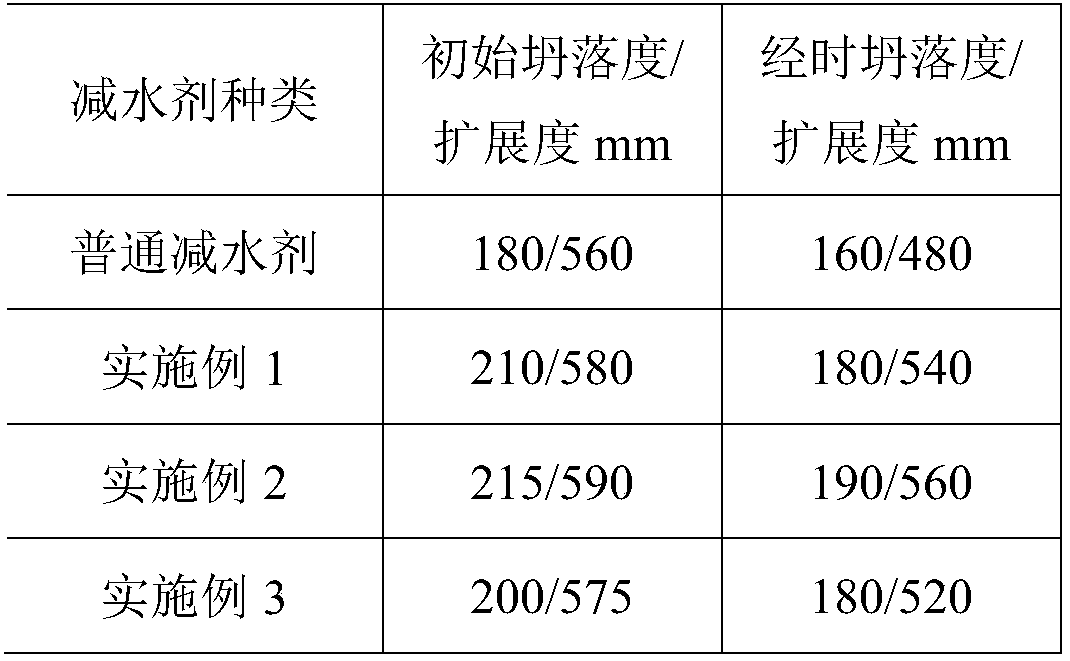A kind of polycarboxylate superplasticizer masterbatch with sulfonic acid phosphoric acid group double chain transfer effect
A technology of sulfonic acid phosphoric acid and chain transfer, which is applied in the field of polycarboxylate superplasticizers, can solve problems such as poor compatibility between grinding aids and superplasticizers, complex components of grinding aids, fluctuations in superplasticizers, etc. Achieve uniform distribution of short-chain branched structure of water reducer molecules, improve sulfate resistance and mud resistance, and improve synthesis conversion rate
- Summary
- Abstract
- Description
- Claims
- Application Information
AI Technical Summary
Problems solved by technology
Method used
Image
Examples
Embodiment 1
[0033] A polycarboxylate superplasticizer masterbatch with sulfonic acid phosphoric acid group double chain transfer, characterized in that: the superplasticizer is polymerized from the following components by mass percentage, the total mass of raw materials is 1000, each group The points and process parameters are as follows:
[0034] Primer: 2400 molecular weight isopentenol polyoxyethylene ether: 345, water: 200;
[0035] Oxidant solution: hydrogen peroxide: 3.0, water: 5;
[0036] Sodium hypophosphite: 1.2
[0037] After the oxidant solution and sodium hypophosphite are added at one time, add the initiator and the small monomer solution dropwise within 10 minutes. After the initiator is added dropwise for 10 minutes, start to add the small monomer solution dropwise;
[0038] Initiator: sodium vinyl sulfonate: 3.5, ascorbic acid: 0.68, water: 120;
[0039] Small monomer solution: acrylic acid: 38.5, water: 50;
[0040] Initiator dropping time: 4.5h;
[0041] The small ...
Embodiment 2
[0045] Primer: 2400 molecular weight vinyl butyl ether polyoxyethylene ether: 348, water: 220;
[0046] Oxidant solution: hydrogen peroxide: 3.5, water: 5;
[0047] Sodium hypophosphite: 3.5
[0048] After the oxidant solution and sodium hypophosphite are added at one time, add the initiator and the small monomer solution dropwise within 10 minutes. After the initiator is added dropwise for 10 minutes, start to add the small monomer solution dropwise;
[0049] Initiator: sodium allyl sulfonate: 5.7, ascorbic acid: 0.52, water: 120;
[0050] Small monomer solution: acrylic acid: 35.6, water: 50;
[0051] Initiator dropping time: 5.5h;
[0052] The small monomer solution dripping time is 5.0h;
[0053] Hydration: 208.18.
[0054] Insulate for 15h to release the reactor.
Embodiment 3
[0056] Primer: 2400 molecular weight vinyl butyl ether polyoxyethylene ether: 346, water: 250;
[0057] Oxidant solution: hydrogen peroxide: 4.8, water: 10;
[0058] Sodium hypophosphite: 4.7
[0059] After the oxidant solution and sodium hypophosphite are added at one time, add the initiator and the small monomer solution dropwise within 10 minutes. After the initiator is added dropwise for 10 minutes, start to add the small monomer solution dropwise;
[0060] Initiator: sodium methacrylate: 7.8, ascorbic acid: 0.20, water: 115;
[0061] Small monomer solution: acrylic acid: 32.8, water: 50;
[0062] Initiator dropping time: 5.0h;
[0063] The small monomer solution dripping time is 4.5h;
[0064] Hydration: 178.7.
[0065] Insulate for 12h to release the reactor.
[0066] Respectively test the initial slump / expansion and slump / expansion of concrete under the same concentration of the polycarboxylate superplasticizer masterbatch of the above-mentioned example of sulfonic ...
PUM
 Login to View More
Login to View More Abstract
Description
Claims
Application Information
 Login to View More
Login to View More - R&D
- Intellectual Property
- Life Sciences
- Materials
- Tech Scout
- Unparalleled Data Quality
- Higher Quality Content
- 60% Fewer Hallucinations
Browse by: Latest US Patents, China's latest patents, Technical Efficacy Thesaurus, Application Domain, Technology Topic, Popular Technical Reports.
© 2025 PatSnap. All rights reserved.Legal|Privacy policy|Modern Slavery Act Transparency Statement|Sitemap|About US| Contact US: help@patsnap.com

